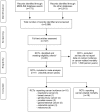Use of fibrates and cancer risk: a systematic review and meta-analysis of 17 long-term randomized placebo-controlled trials
- PMID: 23028888
- PMCID: PMC3446944
- DOI: 10.1371/journal.pone.0045259
Use of fibrates and cancer risk: a systematic review and meta-analysis of 17 long-term randomized placebo-controlled trials
Abstract
Background: Fibrates comprise a class of well-established antilipidemic agents that significantly reduce cardiovascular events. Given the concerns of cancer with fibrate therapy, we undertook a systematic review and meta-analysis to investigate the effects of fibrates on cancer outcomes.
Methods: We systematically searched Medline, Scopus, SCI Expanded, and the Cochrane Library for studies published up to 2012. We included randomized controlled trials (RCTs) that evaluated a fibrate therapy compared with placebo, had a minimum duration of two years, and reported data on the incidence of and/or deaths from cancer during the trial. Reviews of each study were performed and the relative data were abstracted. Pooled relative risk estimates (RR) and 95% confidence intervals (CIs) were calculated using the inverse variance weighted approach. Subgroup, sensitivity and meta-regression analyses were also conducted.
Results: Seventeen RCTs, involving 44,929 participants with an average follow-up of 5.2 years, contributed to the analysis. The degree of variability between trials was consistent with what would be expected to occur by chance alone. The quantitative synthesis of data retrieved from the RCTs was not indicative of a fibrate effect on cancer incidence (780 [fibrate] vs 814 [control]; RR = 1.02, 95% CI 0.92-1.12) or cancer death (385 [fibrate] vs 377 [control]; RR = 1.06, 95% CI: 0.92-1.22). When the analysis was restricted to major RCTs, the results did not substantially change. Similarly, we found no evidence of differential effects by length of follow-up or type of fibrate. Insignificant results were also obtained for the role of fibrates in cancers of the respiratory tract, breast, colon, gastrointestinal tract, prostate, genitourinary tract, or in melanoma.
Conclusion: Our findings demonstrate that fibrates have a neutral effect on cancer outcomes. However, it is important to continue monitoring their long-term safety profiles.
Conflict of interest statement
Figures





Similar articles
-
Folic acid supplementation and malaria susceptibility and severity among people taking antifolate antimalarial drugs in endemic areas.Cochrane Database Syst Rev. 2022 Feb 1;2(2022):CD014217. doi: 10.1002/14651858.CD014217. Cochrane Database Syst Rev. 2022. PMID: 36321557 Free PMC article.
-
Fibrates for secondary prevention of cardiovascular disease and stroke.Cochrane Database Syst Rev. 2015 Oct 25;2015(10):CD009580. doi: 10.1002/14651858.CD009580.pub2. Cochrane Database Syst Rev. 2015. PMID: 26497361 Free PMC article. Review.
-
Fibrate therapy and flow-mediated dilation: A systematic review and meta-analysis of randomized placebo-controlled trials.Pharmacol Res. 2016 Sep;111:163-179. doi: 10.1016/j.phrs.2016.06.011. Epub 2016 Jun 15. Pharmacol Res. 2016. PMID: 27320045 Review.
-
The effect of fibrates on lowering low-density lipoprotein cholesterol and cardiovascular risk reduction: a systemic review and meta-analysis.Eur J Prev Cardiol. 2024 Feb 15;31(3):291-301. doi: 10.1093/eurjpc/zwad331. Eur J Prev Cardiol. 2024. PMID: 37855457
-
Impact of fibrate therapy on plasma plasminogen activator inhibitor-1: a systematic review and meta-analysis of randomized controlled trials.Atherosclerosis. 2015 May;240(1):284-96. doi: 10.1016/j.atherosclerosis.2015.03.016. Epub 2015 Mar 16. Atherosclerosis. 2015. PMID: 25828270 Review.
Cited by
-
Abnormal Metabolism in the Progression of Nonalcoholic Fatty Liver Disease to Hepatocellular Carcinoma: Mechanistic Insights to Chemoprevention.Cancers (Basel). 2021 Jul 11;13(14):3473. doi: 10.3390/cancers13143473. Cancers (Basel). 2021. PMID: 34298687 Free PMC article. Review.
-
Metabolic control of PPAR activity by aldehyde dehydrogenase regulates invasive cell behavior and predicts survival in hepatocellular and renal clear cell carcinoma.BMC Cancer. 2018 Nov 28;18(1):1180. doi: 10.1186/s12885-018-5061-7. BMC Cancer. 2018. PMID: 30486822 Free PMC article.
-
PPARs and Mitochondrial Metabolism: From NAFLD to HCC.PPAR Res. 2016;2016:7403230. doi: 10.1155/2016/7403230. Epub 2016 Dec 27. PPAR Res. 2016. PMID: 28115925 Free PMC article. Review.
-
Longitudinal cohort study highlights cancer-preventive benefits of lipid-lowering drugs.iScience. 2024 Aug 6;27(9):110680. doi: 10.1016/j.isci.2024.110680. eCollection 2024 Sep 20. iScience. 2024. PMID: 39252980 Free PMC article.
-
HDL and LDL: Potential New Players in Breast Cancer Development.J Clin Med. 2019 Jun 14;8(6):853. doi: 10.3390/jcm8060853. J Clin Med. 2019. PMID: 31208017 Free PMC article. Review.
References
-
- Staels B, Fruchart JC (2005) Therapeutic roles of peroxisome proliferator-activated receptor agonists. Diabetes 54: 2460–2470. - PubMed
-
- Després JP, Lemieux I, Robins SJ (2004) Role of fibric acid derivatives in the management of risk factors for coronary heart disease. Drugs 64: 2177–2198. - PubMed
-
- WHO Cooperative Trial Committee of Principal Investigators (1985) WHO cooperative trial on primary prevention of ischaemic heart disease using clofibrate to lower serum cholesterol: mortality follow-up. Lancet 2: 379–385. - PubMed
-
- Heady JA, Morris JN, Oliver MF (1992) WHO clofibrate/cholesterol trial: clarifications. Lancet 340: 1405–1406. - PubMed
Publication types
MeSH terms
Substances
Grants and funding
LinkOut - more resources
Full Text Sources
Other Literature Sources
Medical

